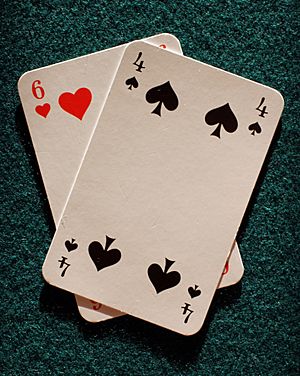Bettelmann facts for kids

6 of Hearts and 4 of Clubs played to a trick
|
|
| Origin | Germany |
|---|---|
| Alternative names | Tod und Leben, Leben und Tod |
| Type | Capturing |
| Players | 2 |
| Age range | 5-6 |
| Cards | 32 |
| Deck | Piquet or Skat pack |
| Play | Alternate |
| Card rank (highest first) | A K Q J 10 9 8 7 A K O U 10 9 8 7 |
| Playing time | 5 min. |
| Random chance | Mainly luck |
| Related games | |
| Battle or War | |
| Very easy to play. No trumps. | |
Bettelmann, which means "Beggar Man" in German, is a simple and fun card game for two players. It's also known as Tod und Leben ("Life and Death") or Woina Wize (Polish for "war"). This game comes from Germany and has been played since at least 1841. It's very similar to the popular game called Battle. Bettelmann is a great game for kids because it's easy to learn and play.
Contents
How to Play Bettelmann
The rules for Bettelmann are quite old, but they haven't changed much over time. Here's how you play:
Game Setup
- You need a deck of 32 cards. You can use either a German-suited or a French-suited deck.
- Each of the two players gets 16 cards.
- Players place their cards face down in a pile in front of them. Make sure you don't look at your cards!
Playing a Trick
- One player starts by flipping their top card face up onto the table.
- Then, the other player flips their top card face up next to it.
- The cards are ranked in their normal order: Ace is highest, then King, Queen, Jack, 10, 9, 8, and 7 is lowest. The suit of the card (like hearts or clubs) doesn't matter.
- The player who played the highest card wins the "trick" (both cards).
- The winner takes both cards and adds them to the bottom of their own face-down pile.
What Happens in a Tie?
- If both players play cards of the same rank (for example, two 9s), it's a tie!
- When there's a tie, the cards stay on the table.
- The player who wins the next trick gets to take all the cards from both tricks.
- Some versions say the player who played the first card in the tied trick wins the tie. The winner of the tie then starts the next trick.
Winning and Losing
- The game continues with players flipping cards and winning tricks.
- The goal is to not run out of cards.
- The first player to run out of cards becomes the "Beggar" (Bettelmann).
- That player loses the game. The player who still has cards wins!
Tod und Leben Variation
Some people play a version of Bettelmann called Tod und Leben, which means "Life and Death." The main difference in this version is how the cards are divided:
- All the red cards (Hearts and Diamonds) are called "Goodies" (die Guten) or "Life" (Leben).
- All the black cards (Clubs and Spades) are called "Baddies" (die Bösen) or "Death" (Tod).
- One player plays with only the red cards, and the other player plays with only the black cards.
- Just like in regular Bettelmann, the highest-ranking card wins the trick, no matter its color.
- If there's a tie, the cards stay on the table. The winner of the next trick takes all the cards.
- The first player to capture all the cards from the other player wins the game!

All content from Kiddle encyclopedia articles (including the article images and facts) can be freely used under Attribution-ShareAlike license, unless stated otherwise. Cite this article:
Bettelmann Facts for Kids. Kiddle Encyclopedia.
